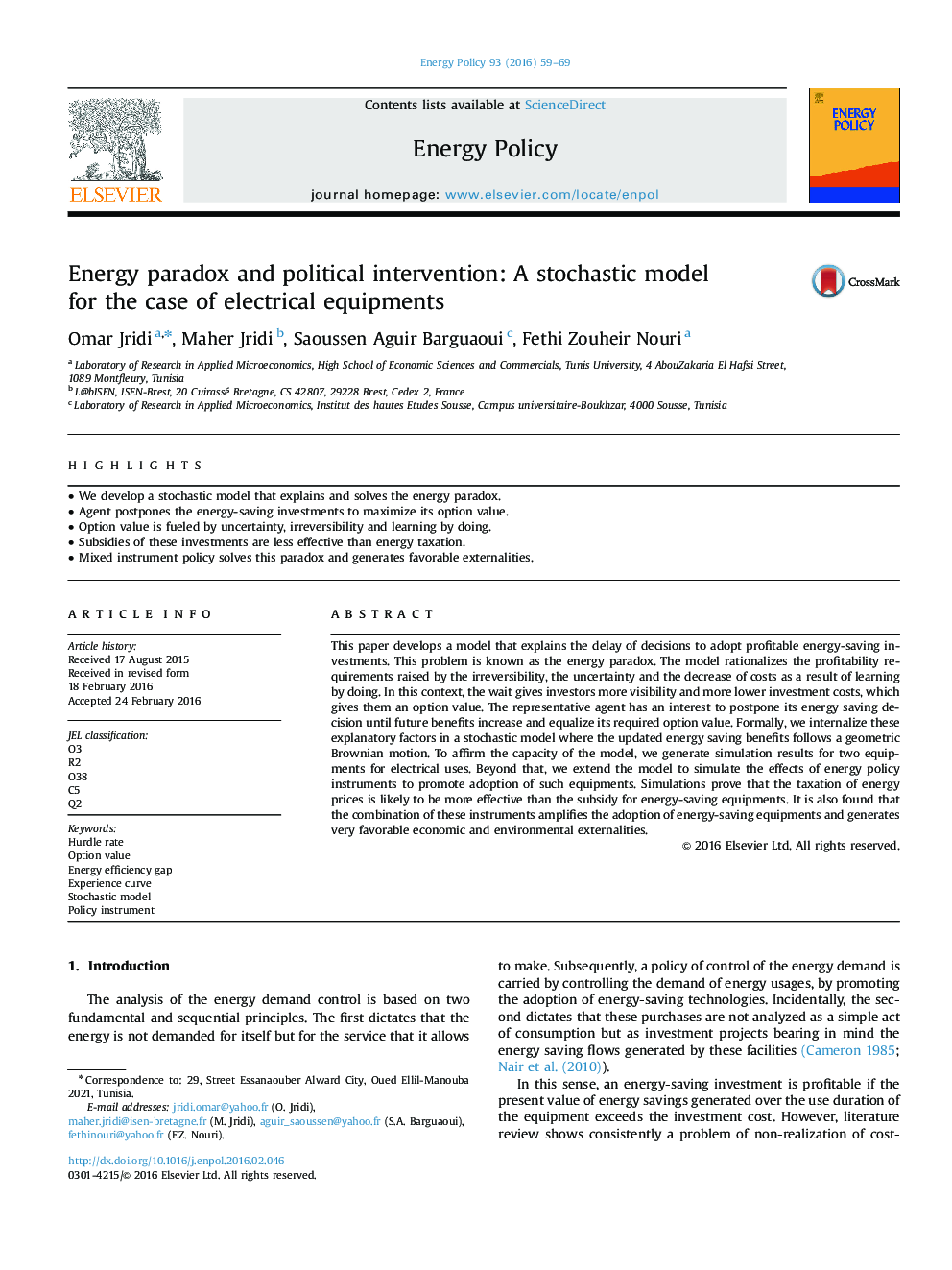| کد مقاله | کد نشریه | سال انتشار | مقاله انگلیسی | نسخه تمام متن |
|---|---|---|---|---|
| 7399117 | 1481265 | 2016 | 11 صفحه PDF | دانلود رایگان |
عنوان انگلیسی مقاله ISI
Energy paradox and political intervention: A stochastic model for the case of electrical equipments
ترجمه فارسی عنوان
پارادوکس انرژی و مداخله سیاسی: یک مدل تصادفی برای مورد استفاده در تجهیزات الکتریکی
دانلود مقاله + سفارش ترجمه
دانلود مقاله ISI انگلیسی
رایگان برای ایرانیان
کلمات کلیدی
ترجمه چکیده
این مقاله یک مدل را ارائه می دهد که تاخیر در تصمیم گیری در مورد سرمایه گذاری های صرفه جویی در هزینه های سودمند را توضیح می دهد. این مشکل به عنوان پارادوکس انرژی شناخته می شود. این مدل منطبق بر نیازهای سودآوری ناشی از عدم برگشت، عدم اطمینان و کاهش هزینه ها به عنوان یک نتیجه از یادگیری با انجام عملیات است. در این زمینه، انتظار می رود سرمایه گذاران بیشتر دید و هزینه های سرمایه گذاری پایین تر، که به آنها ارزش یک گزینه را می دهد. عامل نماینده علاقه مند است تا تصمیم گیری صرفه جویی در انرژی خود را تا زمانیکه مزایای آینده افزایش می یابد و مقادیر مورد نیاز خود را برابر سازد، منتقل کند. به طور رسمی، این عوامل توضیح دهنده را در یک مدل تصادفی که در آن مزایای صرفه جویی در صرفه جویی در انرژی به دنبال یک حرکت هندسی براونی است، درونی می کنیم. برای تایید ظرفیت مدل، ما نتایج شبیه سازی برای دو تجهیزات برای کاربردهای الکتریکی تولید می کنیم. فراتر از آن، ما مدل را برای شبیه سازی اثرات ابزارهای سیاست انرژی برای ترویج پذیرش چنین تجهیزات گسترش می دهیم. شبیه سازی نشان می دهد که مالیات بر قیمت های انرژی احتمالا موثر تر از یارانه برای تجهیزات صرفه جویی در انرژی است. همچنین مشخص شده است که ترکیبی از این ابزارها، پذیرش تجهیزات صرفه جویی در انرژی را افزایش می دهد و باعث ایجاد بی نظمی های اقتصادی و محیط زیست می شود.
موضوعات مرتبط
مهندسی و علوم پایه
مهندسی انرژی
مهندسی انرژی و فناوری های برق
چکیده انگلیسی
This paper develops a model that explains the delay of decisions to adopt profitable energy-saving investments. This problem is known as the energy paradox. The model rationalizes the profitability requirements raised by the irreversibility, the uncertainty and the decrease of costs as a result of learning by doing. In this context, the wait gives investors more visibility and more lower investment costs, which gives them an option value. The representative agent has an interest to postpone its energy saving decision until future benefits increase and equalize its required option value. Formally, we internalize these explanatory factors in a stochastic model where the updated energy saving benefits follows a geometric Brownian motion. To affirm the capacity of the model, we generate simulation results for two equipments for electrical uses. Beyond that, we extend the model to simulate the effects of energy policy instruments to promote adoption of such equipments. Simulations prove that the taxation of energy prices is likely to be more effective than the subsidy for energy-saving equipments. It is also found that the combination of these instruments amplifies the adoption of energy-saving equipments and generates very favorable economic and environmental externalities.
ناشر
Database: Elsevier - ScienceDirect (ساینس دایرکت)
Journal: Energy Policy - Volume 93, June 2016, Pages 59-69
Journal: Energy Policy - Volume 93, June 2016, Pages 59-69
نویسندگان
Omar Jridi, Maher Jridi, Saoussen Aguir Barguaoui, Fethi Zouheir Nouri,
